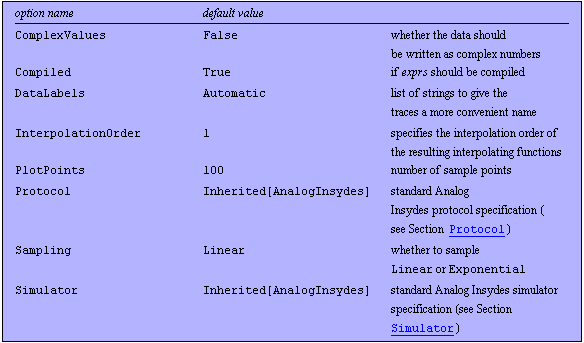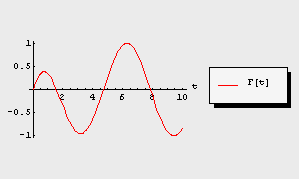|
3.10.4 WriteSimulationData

Command structure of WriteSimulationData.
WriteSimulationData can be used for displaying Analog Insydes results in a post-processor of an external design framework. Therefore WriteSimulationData writes different file formats which are addressed by the option Simulator. WriteSimulationData does not support multi-dimensional data.
WriteSimulationData has the following options:

Options for WriteSimulationData.
See also: ReadSimulationData, Simulator.
Options Description
A detailed description of all WriteSimulationData options is given below in alphabetical order:
ComplexValues
To generate complex-valued data from a small-signal analysis set ComplexValues -> True to write the data as complex numbers.
The default ComplexValues -> False writes real numbers which can be used for DC and transient analyses.
Compiled
With Compiled -> True the expression exprs is compiled with the Mathematica command Compile before evaluation.
DataLabels
With DataLabels -> { , ,  , ,  } you can specifiy new labels for the return value of exprs or for each variable in vars. This is necessary because post-processors often rely on a special name scheme for trace names. Using a Mathematica expression may irritate the post-processor. } you can specifiy new labels for the return value of exprs or for each variable in vars. This is necessary because post-processors often rely on a special name scheme for trace names. Using a Mathematica expression may irritate the post-processor.
InterpolationOrder
With InterpolationOrder -> integer, you can change the interpolation order of the resulting interpolating functions which are generated if the option Simulator is set to "AnalogInsydes". See the Mathematica object InterpolatingFunction.
The default setting is InterpolationOrder -> 1, which is linear interpolation.
PlotPoints
The option PlotPoints -> integer specifies the number of sample points. The default is 100.
Sampling
With Sampling -> Exponential the functions are sampled exponentially. The default is Sampling -> Linear.
Simulator
The following file formats are supported:

Simulators and file types supported by WriteSimulationData.
Examples
Load Analog Insydes.
In[1]:= <<AnalogInsydes`
Write a SaberScope file.
In[2]:= WriteSimulationData["Test.p1.dat",
{(1. - Exp[-t])*Cos[t]}, {t, 0., 10.},
DataLabels -> {"F"}, Simulator -> "Saber"]
View the file "Test.p1.dat" with SaberScope. Alternatively, read it again into Mathematica with ReadSimulationData.
In[3]:= data = ReadSimulationData["Test.p1.dat",
Simulator -> "Saber"]
Out[3]= 
Plot the data with TransientPlot.
In[4]:= TransientPlot[data, "F"[t], {t, 0., 10.}]

Out[4]= 
|